
A Shinto shrine is a structure whose main purpose is to house ("enshrine") one or more kami, the deities of the Shinto religion.

Munakata Taisha (宗像大社) is a collection of three Shinto shrines located in Munakata, Fukuoka Prefecture, Japan. It is the head of the approximately 6,000 Munakata shrines all over the country. Although the name Munakata Taisha refers to all three shrines—Hetsu-gū, Nakatsu-gū and Okitsu-gū—it is commonly used to refer to Hetsu-gū alone. As documented in Japan's second oldest book, Nihon Shoki, the shrines are devoted to the three Munakata goddesses.
Sumiyoshi sanjin (住吉三神) is the generic name for the three Shinto gods Sokotsutsu no O no Mikoto (底筒男命), Nakatsutsu no O no Mikoto (中筒男命), and Uwatsutsu no O no Mikoto (表筒男命). The Sumiyoshi sanjin are regarded as the gods of the sea and sailing. They are sometimes referred to as the Sumiyoshi daijin (住吉大神).

Nangū Taisha (南宮大社) is a Shinto shrine located in the town of Tarui in Fuwa District, Gifu Prefecture, Japan. It is the ichinomiya of former Mino Province. The main festival of the shrine is held annually on May 25. The shrine precincts contain 18 structures from the Edo period, which are designated national Important Cultural Properties. The main building of the shrine is rebuilt every 51 years.
The Engishiki is a Japanese book about laws and customs. The major part of the writing was completed in 927.

Shinto architecture is the architecture of Japanese Shinto shrines.
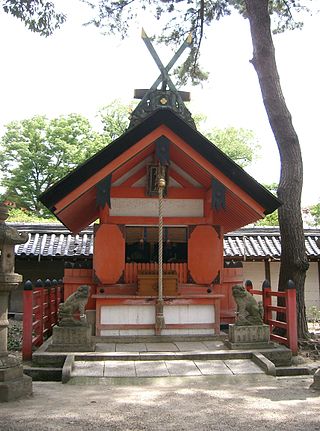
Sumiyoshi-zukuri (住吉造) is an ancient Japanese Shinto shrine architectural style which takes its name from Sumiyoshi Taisha's honden in Ōsaka. As in the case of the taisha-zukuri and shinmei-zukuri styles, its birth predates the arrival of Buddhism in Japan.

The Mishima Taisha (三嶋大社) is a Shinto shrine located in the city of Mishima in Shizuoka Prefecture, Japan. It is the ichinomiya of former Izu Province as well as its Sōja shrine. The main festival of the shrine is held annually on August 16, and features yabusame performances.
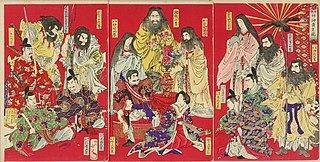
The modern system of ranked Shinto shrines was an organizational aspect of the establishment of Japanese State Shinto. This system classified Shinto shrines as either official government shrines or "other" shrines. The official shrines were divided into
- Imperial shrines (kampeisha), which are parsed into minor, medium, or major sub-categories; and
- National shrines (kokuheisha), which are similarly categorized as minor, medium, or major.

Kibitsu Jinja (吉備津神社) is a Shinto shrine in the Kibitsu neighborhood of Kita-ku, Okayama in Okayama Prefecture, Japan. It is the ichinomiya of former Bitchū Province. The shrine’s main festivals are held on the second Sunday in May and October 15th each year.

Sumiyoshi-jinja (住吉神社) is the Japanese Shinto shrine at Hakata in Fukuoka Prefecture on the island of Kyushu.
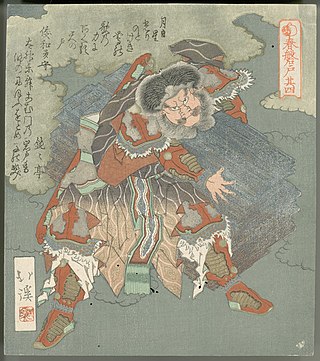
Ame-no-tajikarao (アメノタヂカラオ) is a Japanese deity (kami) who appears in Japanese mythology. Ame-no-tajikarao is written as 天手力男神 in Kojiki, and 天手力雄神 in Nihon Shoki. Tajikarao's name means heaven hand power.
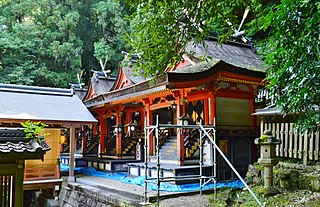
Hiraoka Shrine is a Shinto shrine located in the city of Higashiōsaka, Osaka Prefecture, Japan. It is the Ichinomiya of former Kawachi Province. The shrine's main festival is held annually on 1 February.

Sumiyoshi Shrine may refer to:
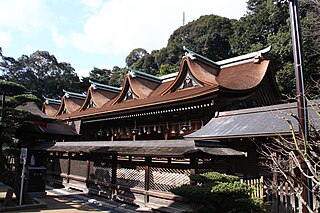
Sumiyoshi Shrine (住吉神社) is a Shinto shrine in the Miyasumiyoshi neighborhood of the city of Shimonoseki in Yamaguchi Prefecture, Japan. It is the ichinomiya of former Nagato Province. The main festival of the shrine is held annually on December 15. Along with the more famous Sumiyoshi-taisha in Osaka and the Sumiyoshi Jinja in Fukuoka, it is one of the "Three Great Sumiyoshi" shrines; however whereas the Osaka Sumitomo-taisha enshrines the Nigi-Mitama, or placid spirit of the Sumiyoshi kami, the shrine in Shimonoseki enshrines the Ara-Mitama, or rough spirit of the kami.

Oarai Isosaki Shrine is a Shinto shrine located in Ōarai City, Ibaraki Prefecture, Japan. It has three torii gates leading into the ocean.

Nunakuma Shrine (沼名前神社) is a Shinto shrine located in Fukuyama City, Hiroshima Prefecture Japan. It is a Gion shrine. It is a Beppyo shrine, or a shrine that is particularly notable in a certain way with a significant history to it. It is located in Fukuyama, Hiroshima.

Iminomiya Shrine is a Shinto shrine located in Chōfu, Japan. It is a Beppyo shrine, or a shrine that is particularly notable in a certain way with a significant history to it. It is a Ninomiya, or a second rank shrine in its province after the Ichinomiya. In this case the Ninomiya and Soja shrine of the province are combined together. Ichinomiya and Soja shrines were often combined.

Shikaumi Shrine is a Shinto shrine located in Fukuoka, Kyushu, Japan. It is located on Shikanoshima island.

Mizuwakasu Shrine is a Japanese Shinto shrine located in Okinoshima, Oki District, Shimane Prefecture. It is a Myojin Taisha. It is the Ichinomiya Oki Province or the highest ranked shrine in the province. It is ranked as a Beppyo shrine, or a special shrine by the Association of Shinto Shrines. The crest of the shrine has a chrysanthemum symbol.



















